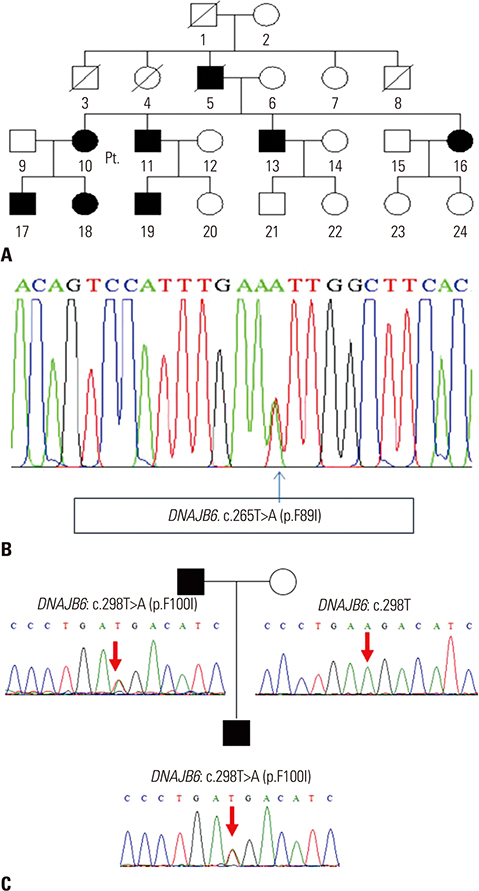Yonsei Med J.
2018 Jul;59(5):698-701. 10.3349/ymj.2018.59.5.698.
Two Korean Families with Limb-Girdle Muscular Dystrophy Type 1D Associated with DNAJB6 Mutations
- Affiliations
-
- 1Department of Neurology, Yonsei University College of Medicine, Seoul, Korea. ycchoi@yuhs.ac
- 2Department of Neurology, Chung-Ang University Hospital, Chung-Ang University College of Medicine, Seoul, Korea.
- KMID: 2412662
- DOI: http://doi.org/10.3349/ymj.2018.59.5.698
Abstract
- Limb-girdle muscular dystrophies (LGMD) are heterogeneous disorders with autosomal inheritance. Autosomal dominant LGMD mapped to 7q36.3 has been classified as LGMD type 1D (LGMD1D) in the Human Gene Nomenclature Committee Database. LGMD1D is characterized predominantly by limb-girdle weakness and may also show a bulbar symptom in some cases. In the past, the frequency of this disease was uncommon, and this disorder was mainly found in Europe and the United States. However, recently, this disorder has been reported in Asia, including Japan, Korea, and Taiwan. Here, we report on three LGMD1D patients, including one with a novel mutation in DNAJB6, c.298T>A. While two patients complained of limb-girdle weakness, as would be expected, one patient had distal weakness. They had various serum creatine kinase levels. Radiologic findings in one patient showed fatty degeneration and atrophy in the posterior part of distal muscles. Pathologic findings in one of the patients showed rimmed vacuoles. Although LGMD1D is still uncommon in Korea, we discovered three Korean patients with LGMD1D, including one novel mutation in DNAJB6, p.Phe100Ile (c.298T>A).
MeSH Terms
Figure
Cited by 2 articles
-
Genotypic and Phenotypic Heterogeneity of LGMD1D due to
DNAJB6 Mutations
Josef Finsterer
Yonsei Med J. 2018;59(8):1008-1009. doi: 10.3349/ymj.2018.59.8.1008.The Author Reply: Genotypic and Phenotypic Heterogeneity of LGMD1D due to
DNAJB6 Mutations
Kitae Kim, Young-Chul Choi
Yonsei Med J. 2018;59(8):1010-1011. doi: 10.3349/ymj.2018.59.8.1010.
Reference
-
1. Iyadurai SJ, Kissel JT. The limb-girdle muscular dystrophies and the dystrophinopathies. Continuum (Minneap Minn). 2016; 22:1954–1977.
Article2. Harms MB, Sommerville RB, Allred P, Bell S, Ma D, Cooper P, et al. Exome sequencing reveals DNAJB6 mutations in dominantly-inherited myopathy. Ann Neurol. 2012; 71:407–416.
Article3. Ruggieri A, Brancati F, Zanotti S, Maggi L, Pasanisi MB, Saredi S, et al. Complete loss of the DNAJB6 G/F domain and novel missense mutations cause distal-onset DNAJB6 myopathy. Acta Neuropathol Commun. 2015; 3:44.
Article4. Couthouis J, Raphael AR, Siskind C, Findlay AR, Buenrostro JD, Greenleaf WJ, et al. Exome sequencing identifies a DNAJB6 mutation in a family with dominantly-inherited limb-girdle muscular dystrophy. Neuromuscul Disord. 2014; 24:431–435.
Article5. Sarparanta J, Jonson PH, Golzio C, Sandell S, Luque H, Screen M, et al. Mutations affecting the cytoplasmic functions of the co-chaperone DNAJB6 cause limb-girdle muscular dystrophy. Nat Genet. 2012; 44:450–455.
Article6. Richards S, Aziz N, Bale S, Bick D, Das S, Gastier-Foster J, et al. Standards and guidelines for the interpretation of sequence variants: a joint consensus recommendation of the American College of Medical Genetics and Genomics and the Association for Molecular Pathology. Genet Med. 2015; 17:405–424.
Article7. Palmio J, Jonson PH, Evilä A, Auranen M, Straub V, Bushby K, et al. Novel mutations in DNAJB6 gene cause a very severe early-onset limb-girdle muscular dystrophy 1D disease. Neuromuscul Disord. 2015; 25:835–842.
Article8. Sato T, Hayashi YK, Oya Y, Kondo T, Sugie K, Kaneda D, et al. DNAJB6 myopathy in an Asian cohort and cytoplasmic/nuclear inclusions. Neuromuscul Disord. 2013; 23:269–276.
Article9. Nam TS, Li W, Heo SH, Lee KH, Cho A, Shin JH, et al. A novel mutation in DNAJB6, p.(Phe91Leu), in childhood-onset LGMD1D with a severe phenotype. Neuromuscul Disord. 2015; 25:843–851.
Article10. Tsai PC, Tsai YS, Soong BW, Huang YH, Wu HT, Chen YH, et al. A novel DNAJB6 mutation causes dominantly inherited distal-onset myopathy and compromises DNAJB6 function. Clin Genet. 2017; 92:150–157.
Article
- Full Text Links
- Actions
-
Cited
- CITED
-
- Close
- Share
- Similar articles
-
- Early-Onset LMNA-Associated Muscular Dystrophy with Later Involvement of Contracture
- Limb-Girdle Muscular Dystrophy
- Mutations of CAPN3 in Korean Patients with Limb-Girdle Muscular Dystrophy
- First Identification of Compound Heterozygous FKRP Mutations in a Korean Patient with Limb-Girdle Muscular Dystrophy
- Progressive Muscular Dystrophy (Report of 32 cases)



